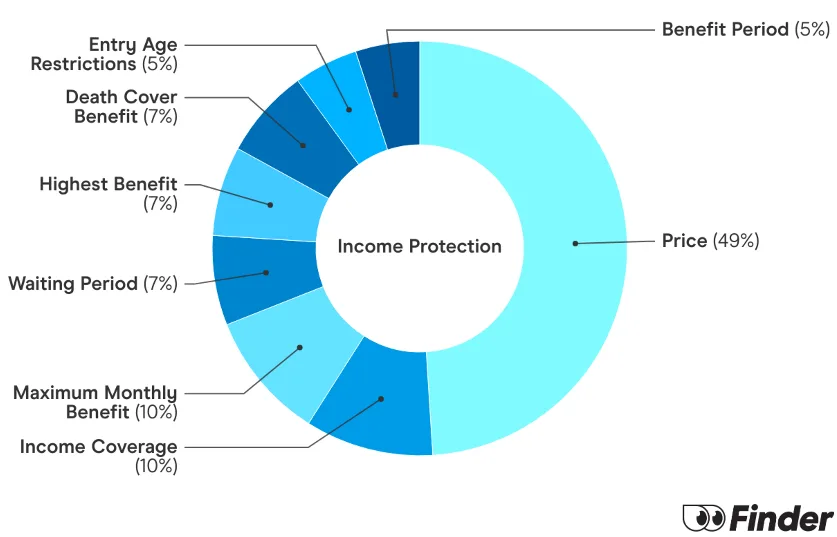Key takeaways
- You can have more than 1 income protection policy.
- Your payouts will be limited to 75% of your income across every policy.
- Most of the time, you should avoid having multiple income protection policies, to avoid having 'zombie' insurance policies.
Compare other products
We currently don't have that product, but here are others to consider:
How we picked theseFinder Score - Income Protection
Income Protection is a little complicated and a lot overwhelming. That's why we made the Finder Score, to make it easier to compare Life Insurance products against each other. Our experts analysed over 12 products and gave each one a score rank out of 10.
But a higher score doesn't always mean a product is better for you. Your situation is unique, so your policy choice will be too. Don't think of Finder Score as the final word, but as a good place to start your life insurance comparison.
How do 2 income protection policies work?
Income protection benefits are capped at 75% of your income. This means if you have two income protection policies and claim on both, your total payout from both will still equal 75% of what you earn. So by having more than two policies, you may be paying for benefits you won't receive. This doesn't mean that you shouldn't have more than one though.
What are zombie insurance policies?
In 2018 the Productivity Commission published a paper about the number of Australians that have useless insurance policies, known as 'zombie' policies. You know, because they're actually dead, even if they look alive? It's actually very funny for the Productivity Commission, they're normally quite dull.
Anyway, one of the biggest forms of zombie insurance included multiple income protection policies, mostly stemming from Australians that have multiple superannuation accounts. It's always a good idea to try and stick to a single super account, and to ideally limit the number of income protection policies you have.
Why have more than one income protection insurance policy?
People choose to have multiple income protection policies to help them manage short- and long-term financial loss that might be caused by illness or injury. A common strategy is to:
- Receive cover in the first 2 years of disability with one policy that pays a reduced benefit (60% of income for example)
- Then combine it with a policy that has a 2-year waiting period that pays (75% of the insured person's income for to age 65 for example).
What is the maximum benefit amount that I can receive with income protection?
The benefit amount that you can insure with Australian income protection plans is up to a maximum of 75% of your gross annual income. Your annual income may include:
- Salary
- Commissions
- Bonuses (you may need to provide proof that you have received them three years in a row to be eligible)
- Overtime payments
- Reportable fringe benefits
- Superannuation contributions
Some insurance providers may offer an excess of up to 15% in cover; however, the additional amount must be used as superannuation contributions.
Why am I only covered for up to 75% of my income?
You are only covered for up to 75% of your income because there should be an incentive for you to want to return to full-time employment when you have fully recovered. Income protection should be treated as a form of support while you are temporarily disabled, so you have the financial capability to cover basic necessities and maintain your family's lifestyle.
When will income protection payments be reduced?
In Australia, income protection is designed to cover a percentage of your income. Insurers will generally cover up to 75% of your income to incentivise you to return to work. This usually means your combined amount would be capped at that percentage.
What other income sources can reduce income protection payments?
- Another insurance policy
- Regular payments from another insurance policy
- Regular payments from a superannuation/pension
- Regular payments from workers compensation
- Regular payments from a motor accident claim
- Any other claims
Income protection inside super vs outside super
If you have two income protection policies – one within your superannuation fund and another outside super, the limitation on the benefits you receive each month will still apply. However, some super funds may offer an extended waiting period feature, which allows you to receive the benefit payments from your income protection policy inside super, even when you have another cover in place with your other insurance provider.
You may choose to receive your benefits at the end of your super policy waiting period. However, with extended waiting period, you may receive your payments from the policy inside super fund once the benefits from the other insurance provider cease. You must continue to be disabled to receive the benefits.
It is important to note that not all superannuation fund offer this feature. Consult with your respective super fund if you have any doubts with owning multiple policies – inside and outside superannuation environment.
How do insurance providers know if you have multiple income protection policies?
Insurance providers are able to share information about customer's claim histories and so it is important to disclose any relevant information, including whether you have existing policies. If an insurer discovers that you have not disclosed information such as this, your claim payout may be impacted negatively.
As such, it's important to be completely honest with the details that you submit in your claim. This could include other policies, but also other compensation you've received, like from workers comp. Otherwise you risk losing your payout, or could even put yourself at risk of fraudulent behaviour.
Talk to a broker about income insurance
Frequently asked questions
Sources
Ask a question
4 Responses
More guides on Finder
-
HCF Income Protect Insurance
Wondering if HCF Income Protection Insurance is right for you? We break down what’s covered, what’s not and whether it offers good value.
-
Cost of living comparison
How much could you save if you lived in a different city in Australia? Let's find out.
-
Is income protection worth it?
Income protection can be a valuable form of cover for Australians when its features are fully understood.
-
Cost of income protection in Australia
Income protection costs can range from around $50 to $160+.
-
Sole trader income protection insurance
Income protection for sole traders provides financial support, via a monthly payment, if you’re unable to work due to illness or injury.
-
Income Protection Insurance vs Mortgage Protection
Does income protection provide the same thing as mortgage protection? Read on and compare.
-
Personal Accident Insurance vs Income Protection
Although income protection and personal accident cover both provide you with income replacement, there are key differences. Read on and compare.
-
Income Protection for Casual Workers
Find out when it is possible for part-time and casual workers to take out income protection insurance.
-
Income protection insurance calculator
Find out how much your income protection insurance policy will pay out in the event of a claim. Receive quotes for income protection and apply securely.
-
Best income protection, Australia
Looking for the best income protection insurance but not exactly sure where to start? Compare the Finder Awards 2025 insurance winners.



I have a personal income protection policy and my employer also has provided one for the workers of their company can I claim both if illness prevents me being able to work for some time.
I thought I only had one income protection insurance, however I’ve realised that I have 3, 2 of which I took out some years ago.
Reading the exclusions it’s confusing as to whether I can claim on all 3 policies or whether one negates the other.
Can you advise.
Hello Lynn,
Good day! Appreciate you contacting finder regarding your inquiry today.
Generally, when you have more than once income protection policy in place, you will be able to claim from more than one income protection policy but your insurers will reduce your benefit amount by any compensation received from other sources.
It’s a good idea to get in touch directly with your insurers to get a clearer view regarding exclusions and restrictions on claiming as it varies per insurance provider.
Hope this helps!
All the best,
Ron
Hi Richard,
Thank you for your question.
You will be able to claim from more than one income protection policy.
Note: At the time of claim, your insurer will ask whether or not you have made or intend to make a disability claim with any other insurers or organisations, such as Centrelink or worker’s compensation. Your insurer may adjust the benefit payment in relation to the second payment.
It’s a good idea to get in touch directly with your insurer to get a more clear view on this matter.
All the best,
Zubair